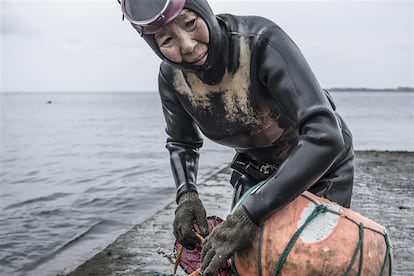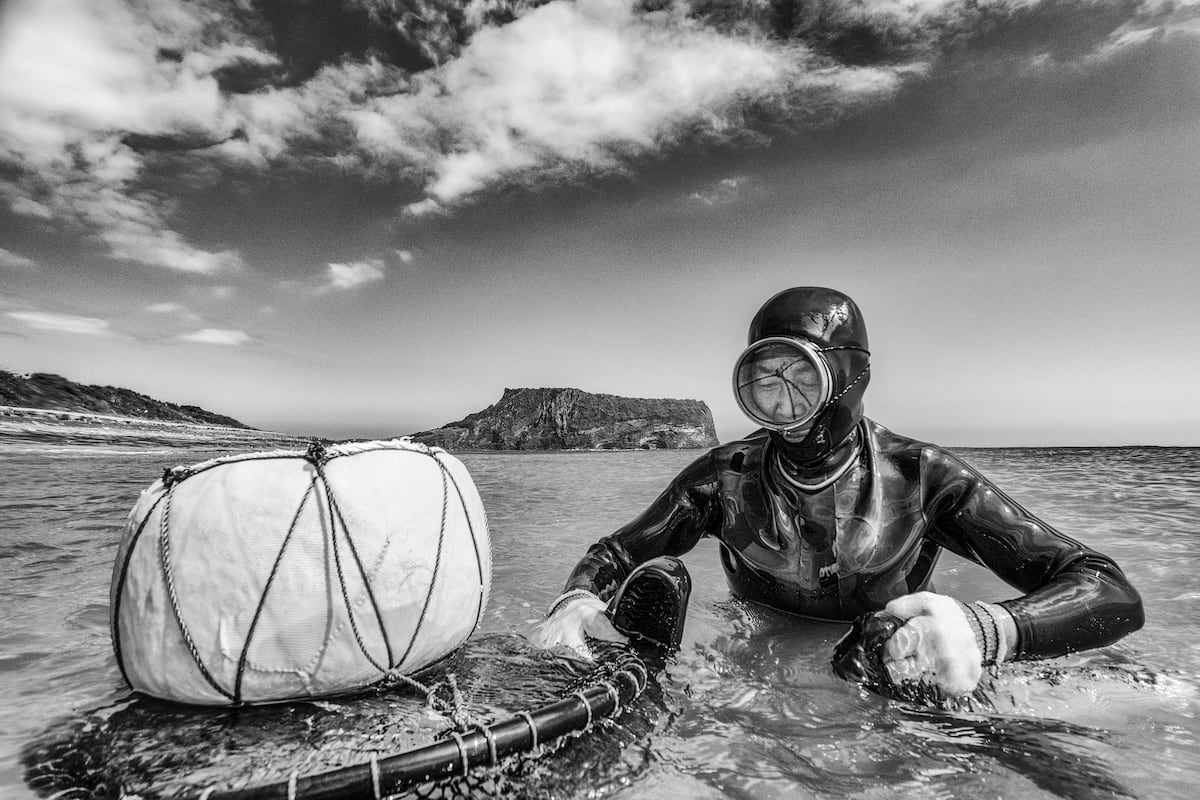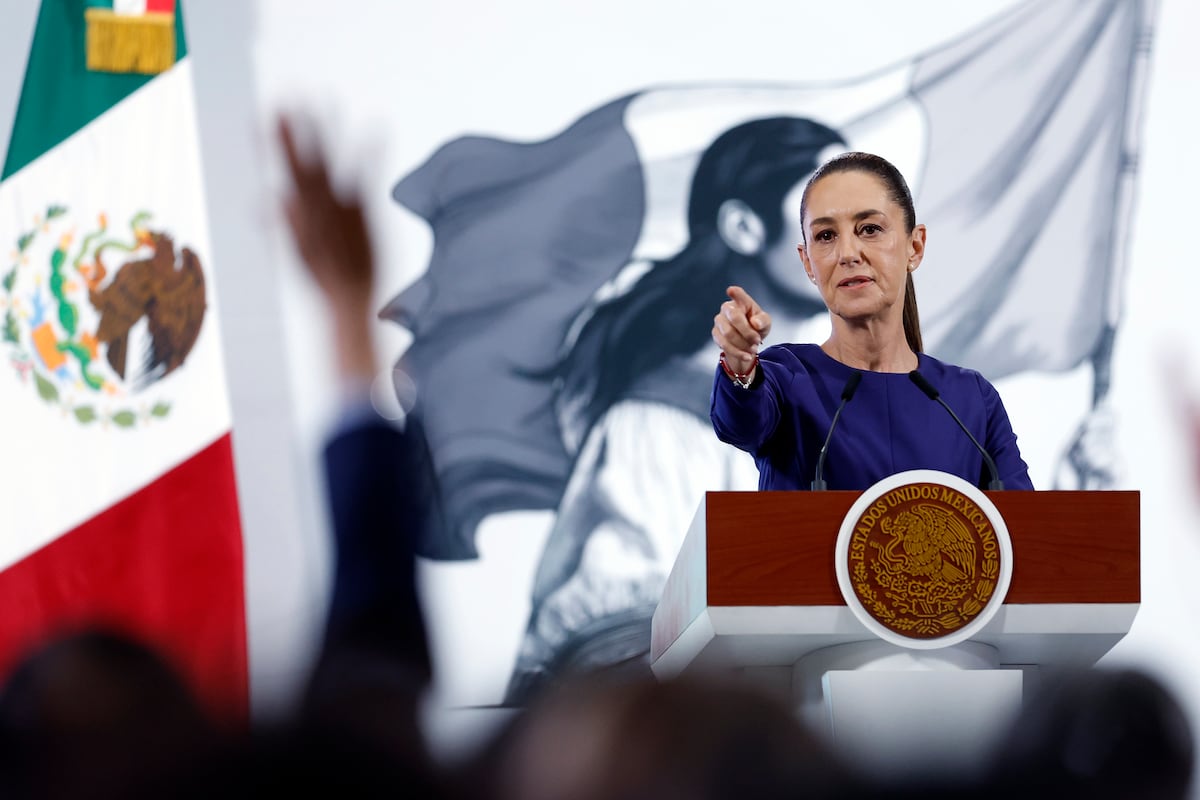No matter how rough the waves or how strong the wind, the haenyeo, or women of the sea, don’t hesitate to dive into the icy waters surrounding the South Korean island of Jeju to collect abalone, seaweed, or sea urchins. They can travel to depths of 10 meters without breathing equipment, even while pregnant. What seems like an almost supernatural mastery of the ocean isn’t just the result of training that begins at age 10. Part of their skills are written in their genes, suggests a new study in the journal Cell, which unravels the aura of mystery surrounding these octogenarian women who dive with a knife in hand wearing only goggles and fins.
University of Utah geneticist Melissa Ilardo and colleagues from the U.S., Denmark, and South Korea compared the traits of 30 female divers with those of 30 non-haenyeo individuals from the volcanic island, as well as 31 residents of the mainland. The researchers compared the participants’ heart rates and blood pressure at rest and during simulated dives, in which they held their breath while submerging their faces in containers of cold water.
The analysis published last Friday not only indicates that Jeju residents share an ancestral lineage, but also discovered two peculiar traits in the swimmers. Their heart rate slows significantly during diving, a response that has been observed in professional freediving swimmers. And behind this ability, scientists suspect, lies a genetic key yet to be fully explored.

“We found an evolutionary adaptation that appears to reduce diastolic blood pressure [when the heart is at rest between beats]. We believe it somehow affects their blood vessels, making it safer for them to swim and hold their breath, even during pregnancy,” Ilardo explains to EL PAÍS. This variant was found in 33% of the participants on the volcanic island, but only in 7% of the participants in South Korea.
During the simulated dives, all participants showed a decrease in their heart rate, but in the haenyeo dives, it decreased by 18.8 beats per minute (bpm) on average, compared to a decrease of 12.6 bpm in the non-divers from Jeju. “This gene influences vascular inflammation — how blood vessels respond to changes in blood pressure — and we believe that this is where the protective effect comes from,” adds the study’s lead author, a characteristic likely due to the divers’ training.

Haenyeo not only challenge their own bodies with the pressure and physical exertion of diving, but they also face frigid temperatures, especially during the island’s long, cold winters, which extend from December to mid-March. Despite this, these divers show a surprising tolerance for low temperatures.
What makes them so resilient? The study’s authors suggest that this phenomenon could be explained by the presence of a gene that makes them less vulnerable to hypothermia, allowing them to withstand extreme underwater conditions without suffering the typical adverse effects of the cold.
A tradition that is at risk of disappearing
The tradition of female divers was declared an Intangible Cultural Heritage of Humanity by UNESCO in 2016. Haenyeo have been recognized not only for their physical prowess and contribution to the local economy, but also as an emblem of women’s empowerment through matriarchal societies.
Knowledge and wisdom have been passed down from generation to generation, the Korean Cultural Center in Argentina tells EL PAÍS. “The haenyeo of Jeju Island have established a unique culture that values coexistence with nature through an ecological diving system,” they note. Through his lens, French photographer José Jeuland, founder of Coco Creative Studio, has been fortunate enough to capture the essence of these women, whose tradition is disappearing.
Jeuland clearly remembers his first visit to Jeju. “I rented a motorbike and toured the island. Every time I saw a haenyeo on the shore, I would stop. I would stand there, watching, trying to understand their routine, their lives,” he says. What struck him most was the vitality emanating from these women, many of whom are between 60 and 80 years old.
“They’re healthy, active. They seem to have boundless energy. In many countries, when people retire, they tend to become more sedentary, but they continue to immerse themselves in the water,” he says. They, on the other hand, remain healthy. For him, it’s clear that this activity not only keeps them alive, but also gives them a unique vitality.
On one of his visits, Jeuland had the opportunity to photograph a group of about 20 women. The next day, one of them died during a dive. It’s a demanding activity, and since many of them are older, they can overexert themselves. “It’s tough,” he says.
Every trip to the sea is part of a cycle that, for them, is as natural as breathing. For the haenyeo, the ocean is not just a workplace; it’s a life partner, an ally that has accompanied them from childhood to old age.
Sign up for our weekly newsletter to get more English-language news coverage from EL PAÍS USA Edition







Comentarios